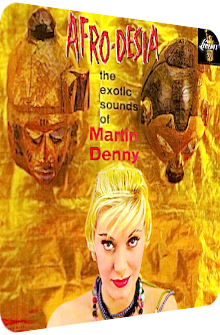
Martin Denny
Afro-Desia
1959
Afro-Desia sees Exotica luminary and pianist Martin Denny (1911–2005) venture into African landmarks shrouded in mystery. Recorded in Hollywood, released in 1959 on Liberty Records and realized with the help of percussionist and birdcaller August “Augie” Colón, mallet instrumentalist Julius Wechter, bassist Harvey Ragsdale as well as a more than prominent omnipresence of the Randy Van Horne Singers who take over the task of the Jack Halloran Singers off Denny’s Asian dreamscape Hypnotique (1959) to great success, Afro-Desia presents 12 compositions, three of them co-written by Martin Denny, and one of these three being possibly the most-feared and usually avoided take of all times; it’s the arrangement, baby!
Considering the wide range of material and the occasional short stop at South American locations, this quasi-African album is still not without its critics: despite the use of authentic African percussion instruments, the created soundscapes and Africanized interpretations are not authentic at all. The onomatopoeic hokey-pokey of the choir is completely fantasized. There are listeners in the 21st century who despise such tactics and call them racist or insulting. I cannot deny such notions. I can only apologetically point to the year of release and the fact that I am reviewing a clear cut Exotica album, and Exotica is never about the truthful truth, but transforms constructed figments of could-be incidents and an exciting escapism into music. It so happens that I personally do not mind the savage shouts and cheerful chants, as I find them tremendously valuable in regard to the creation of a mystical, danger-free tour de force. With this disclaimer and an open mind, the African jungle is all yours. Although it is wise to severely rethink this approach in terms of the infamous first tune!
The opener is the benchmark and milestone of Martin Denny, but for different reasons, so I dedicate a whole paragraph to it. Over the decades, its impetus has grown and driven many a listener into a state of agony and fear. Enter the brutish Tsetse Fly, the most avoided of Denny’s composition ever. Co-written with longtime collaborator Hal Johnson, it is despised for its unnerving simulation of said fly. Children know this effect by heart, and so does the Exotica luminary: Martin Denny presses his lips together and compresses air out of them, resulting in a kind of spluttering snort in upper mid-frequencies. The stereo effect was surely awe-inspiring back then, but this virtual fly is definitely a source of evil and doom in this arrangement, for everything else shines. A Tijuana-like timbre is unleashed by Julius Wechter’s marimba droplets, Denny’s piano is warmhearted, Augie Colón’s bongo aorta is gentle and Harvey Ragsdale’s double bass accents add depth to the uplifting, designedly tipsy and good-natured tune. Every time the listener becomes one with the vibe of the golden-shimmering scenery, the pestering insect comes back for another attack, lusting for blood. Tsetse Fly is a prime example of program music and the legendary myths that establish themselves in-between and around a tune, eventually letting it grow out of proportions. Even though it is still as simple a tropical ditty as in 1959, the collective reception of it has made an elephant out of a fly. There are listeners who avoid this tune like the plague. And in the end, their adamant rampart is justified: after all, the tsetse fly is the plague!
Ma’Chumba is another Johnson-Denny collaboration of the vesiculating staccato kind. Featuring the faux-African vocal talents of the Randy Van Horne Singers, it comprises of the green verdure of Wechter’s six-note arabesques on the marimba, croaking guiros, a sparse bongo rhythm as well as an all-vocal segue whose wideness is depicted by the singer’s echoey afterglow. Seemingly tribal but good-spirited, Ma’Chumba is willfully played and performed over the top. Ernesto Lecuona’s Jungle Drums is the first proper Exotica tune on the album with a more streamlined jazzy rhythm and not too much eclecticism (those looking for tachycardia, check out Stanley Black‘s take as featured on Exotic Percussion from 1962). Launching with Colón’s warbled birdcalls and buzzing bongos, venturing to a mallet instrument extravaganza loaded with glitzy glockenspiel glissandos plus soothing vibraphones, and culminating in the unison of the Randy Van Horne Singers’ majestic aah-aah lyrics with Denny’s sun-soaked piano chords, it is Ray Bryant’s Cubano Chant which unleashes a gargantuan beast in the shape of a multifaceted percussion shrubbery, a shrapnel of vocals and chants as well as rustic piano chords. Wechter’s hefty marimba serpentines are equally superb. One of the craziest midtempo interpretations of this gem.
Surprisingly enough, Martin Denny had thus far never come up with his own arrangement of Ary Barroso’s classic Baía, but on Afro-Desia, the time is finally right, if not perfectly congruent with the African topic. This is vintage Exotica alright, with Augie Colón imitating a whole flock of birds and the choir dropping bazooba-zooba and dee-dee Space-Age wisdoms. The mood is dusky and gentle, the maracas sizzle mildly, the vibrato of Wechter’s marimba is languorous, the admixed glockenspiel stardust nutritious and the famous melody astutely carved out. Arthur Lyman’s take on the eponymous LP Bahia (1959) may be more staggering, energetic and vivacious, but the hatched pastel colors of Denny’s version are perfectly loveable and make this a very strong take overall. Side A closes with Hal Mooney’s Swamp Fire, a downwards spiraling pandemonium of fiery pianos of the Latin kind, energetically shaken maracas and a great thicket of boo-bams and congas which augment the scenery of voodoo magic in accordance with Colón’s vocal range. Frogs, birds and insects all live happily together in this moist hallucination.
A downtempo interpretation of Temptation opens side B. Arthur Freed’s and Nacio Herb Brown’s crepuscular-arcane panorama sees the return of the Randy Van Horne Singers and their ya ya chants in adjacency to plinking shakers, wooden claves and clinging mallet instruments, whereas Les Baxter’s Simba is a carefree ditty of screaming tigers, illuminated piano chords and a specifically vivid Augie Colón in tandem with the deep vocals of the choir. Gleeful marimba chords, dissonant tsetse-like kazoo-esque brass instruments and mixed chants round off the aural sunburst. After Simba comes Mumba. Martin Denny and Hal Johnson wrote this piece with Randy Van Horne. It is driven by a talkative voodoo priest and susurrant female chants. The polyphony of the vibes is gorgeous, but the spectral echoes that reign in the background are simply awe-inspiring. I do not even dare to ask how those were created. Like ghostly apparitions, these voices from the past add a serious undertone to the musical steppe.
The following Aku Aku is one of Julius Wechter’s transparent compositions in the clear, so to speak, for his input was far greater than the liner notes of Denny’s albums would ever admit. Aku Aku is another formidable tune. The complexion of the polyphonous vibes is wondrous and inherits a sort of tension that is often heard in Martin Denny’s albums. A fusion of excitement and easiness is baked into each chord. The gyrating xylophone, however, is freed from such notions and comes along in a bucolic fashion. The bongo layer is tribal yet disciplined, and as an added bonus, the composition ends in a breakneck speed and emits cavalcades of birdcalls.
Ralph Rainger’s obscure Raftero is a Yiddish-Latin hybrid of sanguine piano chords and scintillating wood-pecking xylophone spirals, with the singers chanting in serious and delighted manners. I am not too fond of the mercilessly dark overtones and the incompatible cheekiness of Wechter’s mallet instrument layers, but be that as it may, the same assertion can be applied to the closer Siboney. Augie Colón kicks off Ernesto Lecuona’s gold standard with croaking frogs and squawking birds. Harvey Ragsdale is also prominently audible, for the reduced soundscape only features vibes, marimbas and maracas which are played in a reduced tempo that allows each instrument’s sustain to conflate with the darkness. The second phase sees a faster Bossa Nova rhythm which eventually turns into a frantic Merengue wild ride with hectic bongos, rapidly shaken maracas and benign piano tercets. This is still not the end of the line, for the final 20 seconds comprise of an even faster tempo. Mayhem, turmoil and upheaval!
Short fleeting visits into South American countries aside, Afro-Desia is a gloriously poeticizing African album and lives up to the expectations Exotica fans have in regard to Martin Denny. What the arrangements lack in piano chords, they deliver with mallet instrument goodness, birdcalls and vocals. As is the case with the album’s predecessor Hypnotique, the Randy Van Horne Singers seriously add greatness and a colorful verve to each song they appear on, as did the Jack Halloran Singers before them. Some of their fake gibberish is way too much and seriously insulting from an academic viewpoint – the signal term is cultural studies – but as usual, this is up for debate and does not degrade the stylistic success and shapeshifting vocal range of the album. The interpreted material is wisely chosen and the amount of birdcalls very impressive.
No wonder that Augie Colón did not want to be reduced to the famous shtick he was primarily known for. His second solo album Chant Of The Jungle (1960) neglects this feral mimicry altogether. Colón’s work on the bongos, boo-bams and congas is also splendid and above all criticism. While the three tracks by Martin Denny and Hal Johnson do not reach the class of, say, their track Primitiva (on 1958's Forbidden Island), there is still the malevolent Tsetse Fly whose buzzing flaps haunt and annoy listeners to this day which is quite an achievement. The one and only tune of faux-Polynesian flavor would be Ary Barroso’s Baía. Literally de trop in an African setting, its inclusion does not destroy the overarching theme but carefully adjusts it for a few minutes. The spirit of the genre-constituting Exotica (1957) is resurrected during this timeframe. If you are in search for an Africa-themed album, Afro-Desia is a splendid starting point, with Tak Shindo’s Mganga! and Chaino’s Jungle Echoes (both 1959) providing other viewpoints of the same topic. Afro-Desia is available on vinyl, a remastered CD and as a pristine download version taken from the remastered source.
Exotica Review 269: Martin Denny – Afro-Desia (1959). Originally published on Oct. 12, 2013 at AmbientExotica.com.
